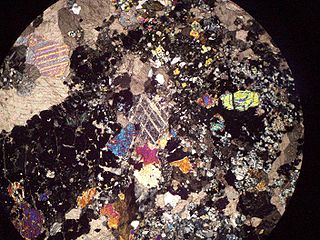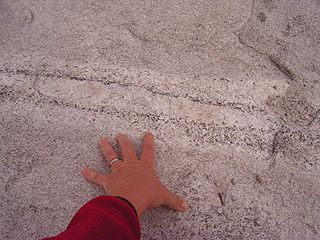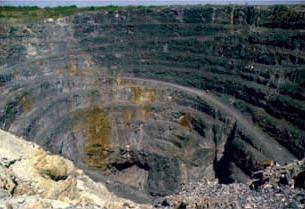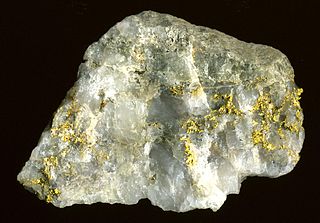Related Research Articles

Amphibolite is a metamorphic rock that contains amphibole, especially hornblende and actinolite, as well as plagioclase feldspar, but with little or no quartz. It is typically dark-colored and dense, with a weakly foliated or schistose (flaky) structure. The small flakes of black and white in the rock often give it a salt-and-pepper appearance.

Skarns or tactites are coarse-grained metamorphic rocks that form by replacement of carbonate-bearing rocks during regional or contact metamorphism and metasomatism. Skarns may form by metamorphic recrystallization of impure carbonate protoliths, bimetasomatic reaction of different lithologies, and infiltration metasomatism by magmatic-hydrothermal fluids. Skarns tend to be rich in calcium-magnesium-iron-manganese-aluminium silicate minerals, which are also referred to as calc-silicate minerals. These minerals form as a result of alteration which occurs when hydrothermal fluids interact with a protolith of either igneous or sedimentary origin. In many cases, skarns are associated with the intrusion of a granitic pluton found in and around faults or shear zones that commonly intrude into a carbonate layer composed of either dolomite or limestone. Skarns can form by regional or contact metamorphism and therefore form in relatively high temperature environments. The hydrothermal fluids associated with the metasomatic processes can originate from a variety of sources; magmatic, metamorphic, meteoric, marine, or even a mix of these. The resulting skarn may consist of a variety of different minerals which are highly dependent on both the original composition of the hydrothermal fluid and the original composition of the protolith.

Metasomatism is the chemical alteration of a rock by hydrothermal and other fluids. It is traditionally defined as metamorphism which involves a change in the chemical composition, excluding volatile components. It is the replacement of one rock by another of different mineralogical and chemical composition. The minerals which compose the rocks are dissolved and new mineral formations are deposited in their place. Dissolution and deposition occur simultaneously and the rock remains solid.

The chlorites are the group of phyllosilicate minerals common in low-grade metamorphic rocks and in altered igneous rocks. Greenschist, formed by metamorphism of basalt or other low-silica volcanic rock, typically contains significant amounts of chlorite.

Lamprophyres are uncommon, small-volume ultrapotassic igneous rocks primarily occurring as dikes, lopoliths, laccoliths, stocks, and small intrusions. They are alkaline silica-undersaturated mafic or ultramafic rocks with high magnesium oxide, >3% potassium oxide, high sodium oxide, and high nickel and chromium.

Volcanogenic massive sulfide ore deposits, also known as VMS ore deposits, are a type of metal sulfide ore deposit, mainly copper-zinc which are associated with and produced by volcanic-associated hydrothermal events in submarine environments.

Greisen is a highly altered granitic rock or pegmatite, usually composed predominantly of quartz and micas. Greisen is formed by self-generated alteration of a granite and is a class of moderate- to high-temperature magmatic-hydrothermal alteration related to the late-stage release of volatiles dissolved in a magma during the solidification of that magma.

Porphyry copper deposits are copper ore bodies that are formed from hydrothermal fluids that originate from a voluminous magma chamber several kilometers below the deposit itself. Predating or associated with those fluids are vertical dikes of porphyritic intrusive rocks from which this deposit type derives its name. In later stages, circulating meteoric fluids may interact with the magmatic fluids. Successive envelopes of hydrothermal alteration typically enclose a core of disseminated ore minerals in often stockwork-forming hairline fractures and veins. Because of their large volume, porphyry orebodies can be economic from copper concentrations as low as 0.15% copper and can have economic amounts of by-products such as molybdenum, silver, and gold. In some mines, those metals are the main product.

Various theories of ore genesis explain how the various types of mineral deposits form within Earth's crust. Ore-genesis theories vary depending on the mineral or commodity examined.
Restite is the residual material left at the site of melting during the in place production of magma.

Sedimentary exhalative deposits are zinc-lead deposits originally interpreted to have been formed by discharge of metal-bearing basinal fluids onto the seafloor resulting in the precipitation of mainly stratiform ore, often with thin laminations of sulfide minerals. SEDEX deposits are hosted largely by clastic rocks deposited in intracontinental rifts or failed rift basins and passive continental margins. Since these ore deposits frequently form massive sulfide lenses, they are also named sediment-hosted massive sulfide (SHMS) deposits, as opposed to volcanic-hosted massive sulfide (VHMS) deposits. The sedimentary appearance of the thin laminations led to early interpretations that the deposits formed exclusively or mainly by exhalative processes onto the seafloor, hence the term SEDEX. However, recent study of numerous deposits indicates that shallow subsurface replacement is also an important process, in several deposits the predominant one, with only local if any exhalations onto the seafloor. For this reason, some authors prefer the term clastic-dominated zinc-lead deposits. As used today, therefore, the term SEDEX is not to be taken to mean that hydrothermal fluids actually vented into the overlying water column, although this may have occurred in some cases.

Clastic rocks are composed of fragments, or clasts, of pre-existing minerals and rock. A clast is a fragment of geological detritus, chunks, and smaller grains of rock broken off other rocks by physical weathering. Geologists use the term clastic to refer to sedimentary rocks and particles in sediment transport, whether in suspension or as bed load, and in sediment deposits.

A polymetallic replacement deposit, also known as carbonate replacement deposit or high-temperature carbonate-hosted Ag-Pb-Zn deposit, is an orebody of metallic minerals formed by the replacement of sedimentary, usually carbonate rock, by metal-bearing solutions in the vicinity of igneous intrusions. When the ore forms a blanketlike body along the bedding plane of the rock, it is commonly called a manto ore deposit. Other ore geometries are chimneys and veins. Polymetallic replacements/mantos are often stratiform wall-rock replacement orebodies distal to porphyry copper deposits, or porphyry molybdenum deposits. The term manto is derived from the Spanish word manto, meaning "mantle" or "cloak".

Seafloor massive sulfide deposits or SMS deposits, are modern equivalents of ancient volcanogenic massive sulfide ore deposits or VMS deposits. The term has been coined by mineral explorers to differentiate the modern deposit from the ancient.
Iron oxide copper gold ore deposits (IOCG) are important and highly valuable concentrations of copper, gold and uranium ores hosted within iron oxide dominant gangue assemblages which share a common genetic origin.
Argillic alteration is hydrothermal alteration of wall rock which introduces clay minerals including kaolinite, smectite and illite. The process generally occurs at low temperatures and may occur in atmospheric conditions. Argillic alteration is representative of supergene environments where low temperature groundwater becomes acidic.
The Merisi Mining District is situated in Adjara region in close vicinity to the Georgian-Turkish border. It is the part of Lesser Caucasus which occurs in the hinterland of the Arabia-Eurasia collision zone, in the broad Alpine-Himalayan orogenic belt. Area of the mining district is about 180 km2.
The Peñasquito Polymetallic Mine is the fifth largest silver mine in the world and the second largest in Mexico. It is located in north-eastern corner of the State of Zacatecas and is wholly owned by Newmont. It is an open pit operation which began operations in March 2010, but still managed to produce 13,952,600 ounces of silver that year. Estimated reserves for the Peñasquito Mine are 17.82 million oz of gold, 1,070.1 million oz of silver, 3,214 tons of lead and 7,098 million tons of zinc. The mine has its own radio station, XHESP-FM 98.9 "Radio Peñasco".
Farallon Negro is a volcano in the Catamarca province of Argentina. Active between about 9-8 million years ago, it was formerly a stratovolcano or a multi vent volcano. Eventually, erosion removed most of the volcano and exposed the underlying structure including subvolcanic intrusions.
Hydrothermal mineral deposits are accumulations of valuable minerals which formed from hot waters circulating in Earth's crust through fractures. They eventually produce metallic-rich fluids concentrated in a selected volume of rock, which become supersaturated and then precipitate ore minerals. In some occurrences, minerals can be extracted for a profit by mining. Discovery of mineral deposits consumes considerable time and resources and only about one in every one thousand prospects explored by companies are eventually developed into a mine. A mineral deposit is any geologically significant concentration of an economically useful rock or mineral present in a specified area. The presence of a known but unexploited mineral deposit implies a lack of evidence for profitable extraction.
References
- ↑ Yant, Marcella (2009). "Hydrothermal Alteration". www.indiana.edu. Indiana University.
- 1 2 3 4 Damian, Floarea (2003). "The Mineralogical Characteristics and the Zoning of the Hydrothermal Types of Alteration from the Nistru Ore Deposit, Baia Mare Metallogenic District". scholarcommons.usf.edu. Studia Universitatis Babeş-Bolyai. Retrieved 18 April 2014.
- 1 2 3 Parry, W. T.; Jasumback, M.; Wilson, P. N. (2002). "Clay Mineralogy of Phyllic and Intermediate Argillic Alteration at Bingham, Utah". Economic Geology. 97: 221–239. doi:10.2113/gsecongeo.97.2.221.